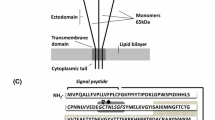Abstract
The possibility of enhancing the immunogenicity of the rabies virus glycoprotein antigen encoded by a DNA vaccine has been investigated. Ubiquitin-like protein FAT10 has been attached to the N-terminus of the glycoprotein to target it to the proteasome and stimulate its presentation by MHC class I. Two forms of the protein, chimeric and original, have been detected in cells transfected with the DNA construct encoding the chimeric protein. The presence of the glycoprotein on the cell surface has been detected by immunostaining of transfected cells. The production of IgG and IgG2a antibodies has been more efficiently induced in mice immunized with the plasmid that encodes the chimeric protein than in those immunized with the plasmid that encodes unmodified glycoprotein. Moreover, the level of IgG2a antibodies exceeded the level of IgG1 antibodies, which indicates a preferential increase in the Th1 component of the immune response. The proposed DNA construct that encodes a modified glycoprotein with a proteasome degradation signal may be a promising DNA vaccine immunogen for post-exposure prophylaxis of rabies.
Similar content being viewed by others
References
Kaur M., Garg R., Singh S., et al. 2015. Rabies vaccines: Where do we stand, where are we heading? Expert Rev. Vaccines. 14, 369–381.
Starodubova E.S., Preobrazhenskaya O.V., Kuzmenko Y.V., et al. 2015. Rabies vaccines: Current status and prospects for development. Mol. Biol. (Moscow). 49, 513–519.
Siegrist C.A. 2008. Vaccine immunology. In: Vaccines, 5th ed. Eds. Plotkin S.A., Orenstein W.A., Offit P.A. Elsevier, pp. 17–36.
Saade F., Petrovsky N. 2012. Technologies for enhanced efficacy of DNA vaccines. Expert Rev. Vaccines. 11, 189–209.
Wang G., Pan L., Zhang Y. 2011. Approaches to improved targeting of DNA vaccines. Hum. Vaccines. 7, 1271–1281.
Starodubova E.S., Isaguliants M.G., Karpov V.L. 2010. Regulation of immunogen processing: Signal sequences and their application for the new generation of DNA-vaccines. Acta Naturae. 2, 53–59.
Sijts E.J., Kloetzel P.M. 2011. The role of the proteasome in the generation of MHC class I ligands and immune responses. Cell. Mol. Life Sci. 68, 1491–1502.
Fan W., Liu Y.C., Parimoo S., et al. 1995. Olfactory receptor-like genes are located in the human major histocompatibility complex. Genomics. 27, 119–123.
Schmidtke G., Aichem A., Groettrup M. 2014. FAT10ylation as a signal for proteasomal degradation. Biochim. Biophys. Acta. 1843, 97–102.
Hipp M.S., Kalveram B., Raasi S., et al. 2005. FAT10, a ubiquitin-independent signal for proteasomal degradation. Mol. Cell. Biol. 25, 3483–3491.
Schmidtke G., Kalveram B., Groettrup M. 2009. Degradation of FAT10 by the 26S proteasome is independent of ubiquitylation but relies on NUB1L. FEBS Lett. 583, 591–594.
Ebstein F., Lehmann A., Kloetzel P.M. 2012. The FAT10-and ubiquitin-dependent degradation machineries exhibit common and distinct requirements for MHC class I antigen presentation. Cell. Mol. Life Sci. 69, 2443–2454.
Schliehe C., Bitzer A., van den Broek M., et al. 2012. Stable antigen is most effective for eliciting CD8+ T-cell responses after DNA vaccination and infection with recombinant vaccinia virus in vivo. J. Virol. 86, 9782–9793.
Grabko V.I. 1991. RF Patent 2008355.
Starodubova E.S., Kuzmenko Y.V., Latanova A.A., et al. 2016. Creation of DNA vaccine vector based on codon-optimized gene of rabies virus glycoprotein (G protein) with consensus amino acid sequence. Mol. Biol. (Moscow). 50, 328–331.
Tomar N.R., Chandra R., Kumar R., et al. 2011. Expression of rabies virus glycoprotein gene into eukaryotic system and determination of potential T-cell epitopes. Indian J. Exp. Biol. 49, 594–599.
Li L., Petrovsky N. 2016. Molecular mechanisms for enhanced DNA vaccine immunogenicity. Expert Rev. Vaccines. 15, 313–329.
Li L., Saade F., Petrovsky N. 2012. The future of human DNA vaccines. J. Biotechnol. 162, 171–182.
Wang Q., Lei C., Wan H., et al. 2012. Improved cellular immune response elicited by a ubiquitin-fused DNA vaccine against Mycobacterium tuberculosis. DNA Cell Biol. 31, 489–495.
Wong S.B., Buck C.B., Shen X., et al. 2004. An evaluation of enforced rapid proteasomal degradation as a means of enhancing vaccine-induced CTL responses. J. Immunol. 173, 3073–3083.
Kaur M., Rai A., Bhatnagar R. 2009. Rabies DNA vaccine: No impact of MHC class I and class II targeting sequences on immune response and protection against lethal challenge. Vaccine. 27, 2128–2137.
Author information
Authors and Affiliations
Corresponding author
Additional information
Original Russian Text © E.S. Starodubova, Yu.V. Kuzmenko, E.O. Pankova, A.A. Latanova, O.V. Preobrazhenskaya, V.L. Karpov, 2018, published in Molekulyarnaya Biologiya, 2018, Vol. 52, No. 3, pp. 527–532.
Rights and permissions
About this article
Cite this article
Starodubova, E.S., Kuzmenko, Y.V., Pankova, E.O. et al. A DNA Construct That Encodes the Rabies Virus Consensus Glycoprotein with a Proteasome Degradation Signal Induces Antibody Production with IgG2A Subtype Predominance. Mol Biol 52, 453–457 (2018). https://doi.org/10.1134/S0026893318030135
Received:
Accepted:
Published:
Issue Date:
DOI: https://doi.org/10.1134/S0026893318030135




